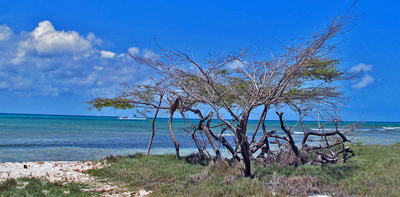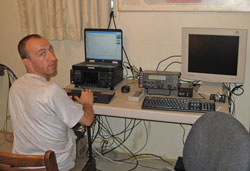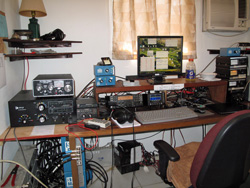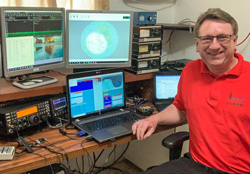Radio Facilities
STATION
The station has been in operation since 1991. After over a decade of expansion and upgrades, it now encompasses all bands from 10 m to 160 m. Over the years, the station has won numerous contests and set many records. Here are some pictures of the operating position, showing the changes since we bought the house in 2003. [Click on any picture to enlarge it.]
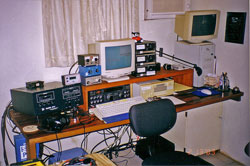
This is the original station, as used in May 2002 by Andy for WPX CW. Note old computers, one radio (FT-1000D).
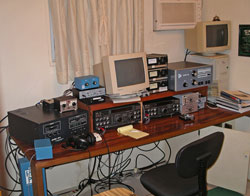
2004 SO2R. Note FT-990/Alpha 86 as second radio. Also Top-Ten decoders, ICE filters, stackmatch for swithching to C31 (left of 87A), 12-volt switching power supply under the Six-Pak controller, with accessory power now run through a Rigrunner power distribution system
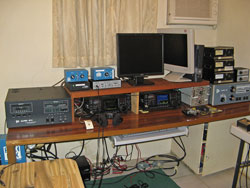
2007, ARRL CW. Radios are now Icom 756 Pro2s. Two Astron 12v power supplies are on the floor. New flat screen monitors are a distinct improvement.
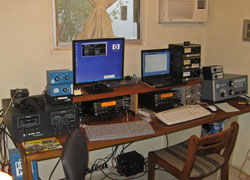
2008 WPX CW. For a multi-two operation with W6LD, AE6Y, W0YK, KX7M, we ran two K3s at the main station desk and two more radios on the side table (see next picture). Note new K9AY beverage switchbox controller next to right K3.
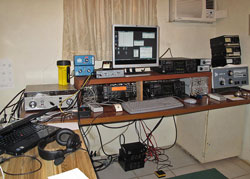
2009 CQWW CW. Andy's setup for a SOAB High Power entry in the big one. Note upper Pro2 being used as a bandscope for the K3; Ten-Tec Titan replacing the 87A that was home for repairs.
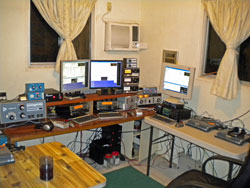
2010 CQWW RTTY. Ed's amazing single-op setup with 3 radios, 3 computers, 3 keyboards and monitors, 2 hands, one brain!
ANTENNAS
[SECOND TOWER AND ANTENNA REFIT, 2019-20]
Aruba has an unforgiving climate for towers and antennas. Though we are not on the water, it's usually windy, and the wind carries dust and salt with it. The result seems to be about a 10-year lifetime, although our 2008 rebuild lasted until late 2019. By that time the towers were certainly unsafe to climb; that's why we did all of our tower work this time with rented man lifts. We replaced all three towers, several guy anchors, all guy wires, the base for one of the towers, and all antennas. Whew! The work was done over 10 days in Oct.-Nov., 2019 and a week in February, 2020 (just beating the coronavirus lockdown). Credit for the work party goes to John W6LD, Andy, AE6Y, and Ed, W0YK. Once again, we got a lot of assistance from Jean-Pierre, P43A, while Andy, K2LE, P40LE also helped out at crucial points in Feb.
Here are the three towers and their respective antennas as of March, 2020.:
-
North Tower (56 feet of Rohn 25)
JK 1015 with dual feed, 5 el. 15, 6 el. 10 on a 36-foot boom Picture -
South Tower (46 feet of Rohn 25)
JK Mid-Tri tribander, 3 el. 20, 4 el. 15, 5 el. 10 on a 24-foot boom Picture Back Tower (67 feet of Rohn 45)
JK 2040 Falcon, 2 el. 40, 4 el. 20 on a 30-foot boom Two-element SteppIR at 43 feet fixed North-South
Inverted vees for 80, 160 Picture-
And in the "cunucu" (i.e., the large public property behind the house), we have four beverages (US West, US East, EU, and East-West) of about 500 feet each, with a common feedpoint about 800 feet from the house with separate RG-6 feedlines. A K9AY switching system in the shack allows any beverage to go to either radio.
[THIS IS THE OLD DESCRIPTION, REPLACED IN 2019-20]
After our week-long work party in February, 2008, we have a whole new suite of antennas. Also three towers new from the base section up (and two of them raised ten feet over their previous heights), and an improved guying system. New as of May 2008 is a much improved set of beverage antennas. Credit for the work party goes to John W6LD, Andy, AE6Y, Ed, W0YK, and Tom N6BT. We got a lot of assistance from Jean-Pierre, P43A, while Andy, K2LE, P40LE also helped out at crucial points, as did Joop, P43JB. In May 2008, the beverage guru was Denny, KX7M, assisted by John.
Here are the three towers and their respective antennas:
-
North Tower (56 feet of Rohn 25)
Force 12 5 el. 15, 2 el. 10 on a 30 foot boom [no kidding, a one-off Tom Schiller special] Picture -
South Tower (43 feet of Rohn 25)
Force 12 C31XR Picture Back Tower (67 feet of Rohn 45)
Force 12 2 el. 40 on an 18 foot boom
Force 12 4 el. 20 on a 30 foot boom
Force 12 80m dipole on a sidemount
160m "C" dipole Picture-
And in the "cunucu" (i.e., the large public property behind the house), we have four beverages (US West, US East, EU, and East-West) of about 500 feet each, with a common feedpoint about 800 feet from the house with separate RG-6 feedlines. A K9AY switching system in the shack allows any beverage to go to either radio.
RADIO GEAR
-
Icom 756 Pro 2
-
Two separate Astron PS's
-
Elecraft K3 and P3
-
Yaesu FT-1000D
-
Alpha 87(A), Alpha 91B, Alpha 86
-
Several iambic and simplex paddles with CMOS-4 keyers
Heil Proset
All sorts of tools, cables, accessories, etc.
The station was designed primarily for a single operator as the antennas are too close for best operation in a multi-transmitter configuration. In 2004 we turned the sation into an SO2R (single-operator two-radio) station using the newly acquired FT-990 and adding appropriate filtering and switchboxes. Changing bands on either radio switches FilterMax filters for the appropriate band and changes the SixPak to the correct antenna. Band decoding is done by Bandmaster Decoders, which control the filters. A Top Ten DX Doubler switches inputs to the radios.
The Standard radio configuration is with two Icom 756 Pro 2s, though we also have an Elecraft K3 and an FT1000D, and lately we have been bringing down our own K3s as well. For example in our multi-two operation in WPX CW in May 2008, we used three K3s and one of the Pro 2s.
COMPUTER
We used to have a station computer, but it was an old one and we found it next to impossible to keep it working with up-to-date logging software, so everyone brings their own laptops instead. Three LCD monitors (17-inch and 19-inch) are on site along with several keyboards (including special mini keyboards that W0YK likes for RTTY). We have keyer interface and rig control cables for the on-site rigs. Internet is now high speed dsl with a wifi modem.
AC POWER
The voltage on the island is 110V and 220V at 60 Hz; plugs are just like the USA. The Radio Room has 110 volt outlets for the radios and station accessories, along with 220 volt outlets for the amplifiers and A/C. There is a 220 outlet in each bedroom for the A/C. Station 12-volt power distribution is by Rigrunner boxes with Anderson Power Poles (extras on site - but best to bring matching cables if you have particular accessories that need 12 volts).
LICENSING
Unfortunately, Aruba is not a CEPT country, so there is no automatic reciprocity. Licensing is straightforward, though bureaucratic. The basic process is explained on the web site of the Aruba ARC. Basically you apply to the Aruban FCC (called the DTZ), which will issue you a license for a year, in the form of, e.g., P4/AE6Y. You can also get special contest calls, like P40L and P40Y valid for a month at a time. The first time you apply, the process takes two to three months or so to complete, so apply early. You pick up the license and pay for it on arrival, or we can arrange to have it picked up for you by Chris, P43C, for a small fee. There are several fees that must be paid to pick up the license.
Reminder
Being a small island, Aruba is a corrosive environment, and it is also fairly windy. As a result, at any given time, antennas may break, feedlines can become disconnected, rotors can get stuck, electronics can fail. Thus, any visitor to the house must understand that there is a possibility, as with any Caribbean site, that one or more antennas or items of gear may not be operable, and may not be fixable during your stay. We try to keep things shipshape, but can offer no guarantees, or refunds, in case of equipment failure.
